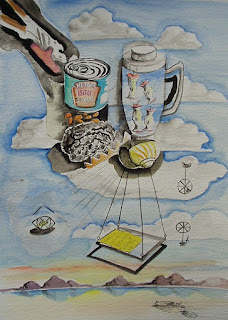PAINTING 2: Exploring Concepts
Part 1 – Painting in Detail
Project: Surrealism
Exercise 1: A painting based on a dream
I have spent a lot of time reading Surrealism published by Dempsey Parr, The World of Marcel Duchamp, 1887 published by Rehtt Austell and Modern Art published by Thames and Hudson. I felt this was essential to my learning experience because I had tended to ignore Surrealism in the past, apart from work by de Chirico and Salvador Dali. However it has been an extremely interesting and enlightening process, and for me an essential part of learning to relax my style and think about humour and threat in painting, and has filled in the missing link between Impressionism and Contemporary art. It has been interesting to see how de Chirico’s style progressed through the movement to Tanguy, Dali and Magritte in particular, as well as other Artists such as Max Ernst, Paul Delvaux and to a lesser extent Francis Bacon.
I think Dali’s work presents some of the greatest detail which make his transformations achieved through what he termed ‘paranoiac critical activity’, convincing and fascinating. Freud’s psychotherapeutic methods were exploiting similar double meanings and are closely allied to Dali’s thinking. Dreams, and association of ideas being explored by both in an exploratory way.
I have looked at advertisements which I have included in my sketchbook together with ideas of how these might be used in paintings.
The Surrealist banner is carried today by Jacques Resch, amongst others and it is interesting to see how is “Les maisons qui volent” has been re-worked in TV advertising.
Compare and Contrast Salvador Dali and Jacques Resch
The work of Jacques Resch is virtually a photographic quality portrayal of objects, so much so that one might think it is air brush work. I enjoy his work not only because of the amazing detail but because of the issues he takes up, for example ‘Le Poisson Disloque’ addresses the issue of fish dying because of the detritus being dumped in the sea. http://www.jacquesresch.com
Comparing his work with Dali and indeed Bosch, one can see the common threads. I am not sure the degree to which inner dreams features in Resch work, I suspect ideas are conceived externally and developed from there, using imagination and possibly images dreams to express the ideas. Dali’s work was an exploration into the subconscious whereas Resch though undoubtedly using subconscious images is concerned with matters of moral, political and social conscience. Whereas Dali on the other hand was effectively illustrating his sub-conscious thoughts as indeed Freud agreed during a meeting they both had, saying rather than being laid bare, he would prefer that the subconscious could be discovered. The concept and technique used by Dali, however, remain extant today, as exemplified in Resch’s paintings.
When I attempted my first Surrealistic painting for this exercise I ended up with a Surrealistic Pop Art piece of work; which, although it had the dream quality elements was not, I thought, in the required style. (see below and on http://www.flickr.com/photos/sylthane )
I therefore decided to produce something with the same elements in the style of Dali/Tanguy. It was less complex but allowed me to transfigure some of the objects and the shadow can be read on the side of the lorry as an old crone carrying a knife. The three blind mice appeared in the foreground and were equally transformed into the cow’s skull. I think I dreamed of the rose heads after reading about a flower-headed woman who, at Dali’s suggestion was used in Trafalgar Square in 1936 to advertise the London Surrealist Exhibition. I think the windowless lorry driving on railway tracks was a recollection of driving on railway tracks in New Zealand back in 1995. As for the traffic lights, I had only recently mentioned on the OCA Forum about the iconic nature of them, but perhaps I shouldn’t be telling you all this and like, Freud, leave you to discover for yourself!
Surrealism Check and Log
§ How did you decide what to include in your images?
Using the recollections of a dream, I wanted to include the main elements, though I have refined these to include transfigurations.
§ How has your style adapted to this subject matter?
I have moved away from the purely representational and introduced humour and a little threat, aspects I would not usually explore. The whole process has loosened up my thoughts and hopefully my work too.
§ What aspects of the surreal approach can you bring to the rest of your work?
I would like to think the absurd may feature and a more original way of thinking by exploring subconscious ideas.






